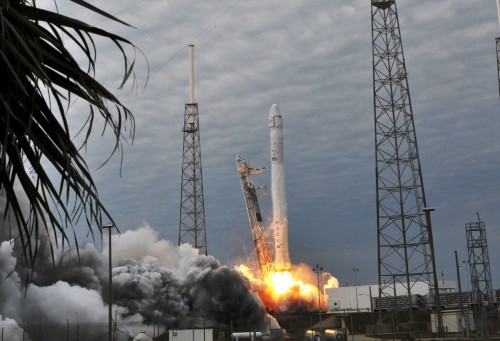
The cold light of day is one of those idioms used in conjunction with the grimness of reality, but today’s rousing launch of SpaceX’s third Dragon cargo mission to the International Space Station—and its second under the terms of the $1.6 billion Commercial Resupply Services (CRS) contract with NASA—experienced no such grimness. For the on-time liftoff of CRS-2 at 10:10 a.m. EST was the first occasion on which an ISS-bound Dragon rose from Earth in daylight; both its inaugural demonstration mission to the station in May 2012 and last October’s first dedicated cargo flight roared aloft in the hours of darkness.
Preparations for the CRS-2 mission proceeded with exceptional smoothness, culminating in a successful static test-firing of the Falcon 9 rocket’s engines Monday. The nine Merlin-1C engines on the first stage pummelled the surface of Space Launch Complex (SLC)-40 at Cape Canaveral Air Force Station, Fla., for several seconds and were automatically shut down without incident. This served to bolster the confidence of SpaceX—the Hawthorne, Calif., company, headed by entrepreneur Elon Musk—following the problematic ascent of CRS-1 into orbit last Oct. 7. That mission suffered a premature shutdown of one of its engines just 80 seconds after launch, and although its Dragon was delivered perfectly into orbit, the anomaly spelled disaster for a small Orbcomm piggyback satellite.
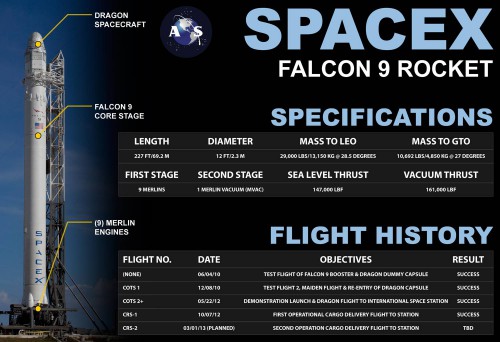
To be fair, last year’s anomaly vindicated SpaceX’s claim that the Falcon 9 can recover from such “engine-out” scenarios, but the resultant investigation pushed the CRS-2 launch back by a couple months from January 2013 into March. In the wake of this investigation, the booster for the CRS-2 mission arrived at Cape Canaveral Air Force Station in late November, and the Dragon craft was mounted atop the Falcon earlier this month. Today’s final preparations ran crisply, with the loading of liquid oxygen and RP-1 (a form of rocket-grade kerosene) propellants completed a little over three hours before the scheduled launch time. The excitement began to build at 10:04 a.m., when the Terminal Count autosequence started, to be followed shortly afterwards by verification from the SpaceX Launch Director that the vehicle was ready to go.
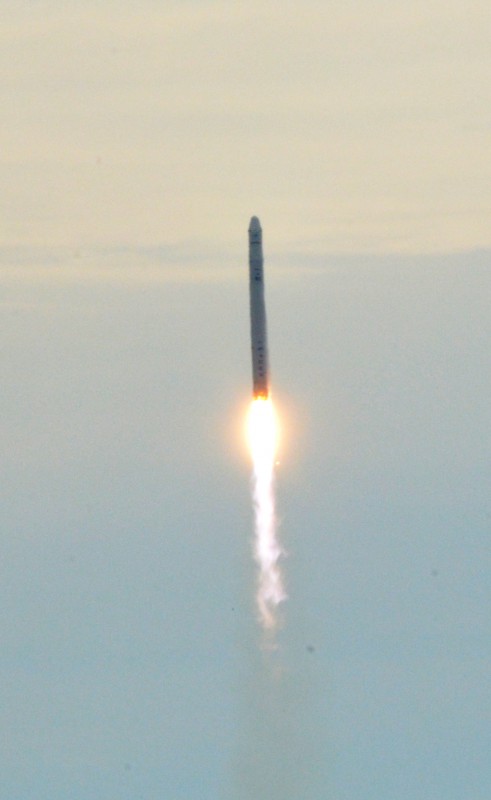
With 60 seconds left on the countdown clock, the Falcon’s command flight computer began its final pre-launch checks and the SLC-40’s “Niagara” deluge system began the process of depositing 30,000 gallons of water per minute through 53 nozzles directly onto the pad surface, forming a vast “curtain” to suppress acoustic waves from the engine plumes and mitigate the vibration effect on the vehicle. At 40 seconds, the propellant tanks were pressurized and at T-3 seconds engine controllers commanded the ignition sequence of the nine Merlin-1C powerplants to commence.Like its predecessors, CRS-2 followed an “instantaneous” launch window, in which every step of preparation was geared toward a liftoff at a very precise time, with no leeway for delay or error. “Everything,” noted SpaceX’s press kit for the mission, “is timed to the exact second of scheduled liftoff. Because an off-time liftoff would require Dragon to use extra propellant to reach the space station, the launch window must be hit precisely. If not, the mission will be attempted on another day.”“Falcon 9 was designed to be the world’s most reliable rocket, and today’s launch validated this by adding to Falcon 9’s perfect track record with our fifth success in a row,” said Gwynne Shotwell, President of SpaceX.
Fortunately, under weather conditions initially described as 80 percent favorable (which turned into 90 percent), and despite a slight risk of wind and cloud violations, the Falcon 9 thundered away from SLC-40 precisely on time. Its nine engines, with a combined thrust of around 1.1 million pounds, provided the impulse for the first three minutes of its ascent. Seventy seconds into the flight, and nearing the point at which its predecessor hiccupped, the vehicle attained supersonic speed and subsequently passed through the area of maximum aerodynamic turbulence—known as “Max Q”—during which time the stresses upon the airframe from extreme velocity and atmospheric resistance were at their worst. At T+170 seconds, two of the Merlins were automatically shut down, as planned, to reduce the rocket’s acceleration, and the remaining engines cut-off, precisely on time, ten seconds later. By now, the Falcon 9 was 50 miles high, above much of the “sensible” atmosphere, and spearing towards orbit.
Five seconds after first-stage cut-off, the second stage—powered by a single Merlin-1C Vacuum engine, with a yield of 100,000 pounds—roared silently to life to begin its 345-second “burn” to inject Dragon into its preliminary low-Earth orbit. (As a side note, at full power the Merlin-1C Vacuum operates with the greatest efficiency ever seen in a U.S.-made hydrocarbon rocket engine.) Finally, nine-and-a-half minutes since leaving the East Coast of Florida, the second stage shut down and the Dragon was separated. At the time of writing, the vehicle was in the process of unfurling its electricity-generating solar arrays, deploying its Guidance and Navigation Control (GNC) Bay Door to expose critical rendezvous sensors, and beginning a complex series of firings of its Draco thrusters to reach the ISS.
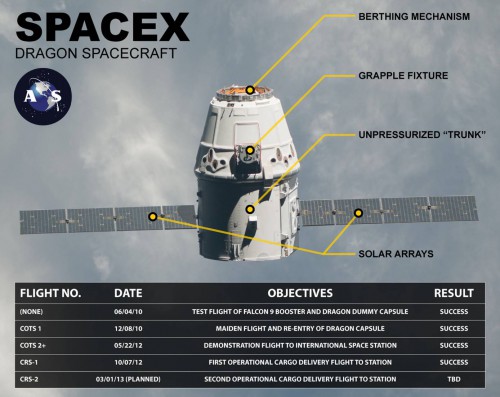
An issue arose with Dragon’s thrusters upon reaching orbit. SpaceX addressed the problem in a release stating the following: One thruster pod is running. Two are preferred to take the next step, which is to deploy the solar arrays. We are working to bring up the other two in order to plan the next series of burns to get to station.
Shortly thereafter the problem apparently was resolved, with Musk tweeting that the solar arrays had been deployed. It was later reported by Robert Pearlman with CollectSPACE.com that all four of Dragon’s thruster pods had been engaged and that all of Dragon’s systems were now “Green.”
As this article was being prepared, the spacecraft was being readied for its “R-Bar” (or “Earth Radius Vector”) rendezvous profile, an imaginary line extending from the center of Earth toward the ISS, meaning it will meet the space station from “below.” In doing so, Dragon will take advantage of natural gravitational forces to brake its final approach and reduce the overall number of thruster firings it needs to perform.
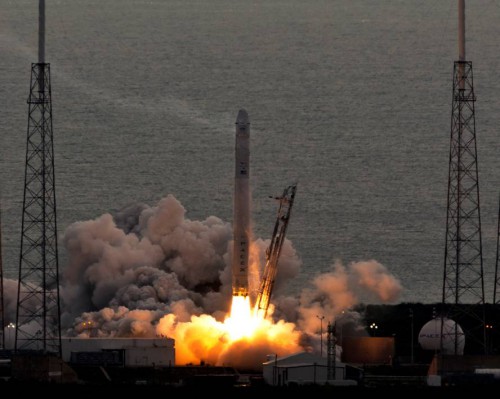
Tomorrow, CRS-2 will establish an ultra-high-frequency communications link with the station, using its UHF communications unit (CUCU), which will enable the incumbent Expedition 34 crew—led by Commander Kevin Ford—to monitor its approach. A carefully orchestrated symphony of maneuvers will bring the craft to a position about 1.5 miles from the ISS, where a “Go/No-Go” decision to proceed will be made. Further Go/No-Go decisions will be made at distances of 3,700 feet, then 820 feet, then 100 feet, and finally 30 feet, before Dragon is captured by U.S. Operating Segment (USOS) crewmen Ford and Tom Marshburn, using the station’s 57-foot-long Canadarm2 robotic arm. Both men will be based in the station’s multi-windowed cupola, which will afford them expansive panoramic views of the rendezvous and docking at the nadir-facing Harmony node.
During these incremental steps toward its quarry, Dragon will employ its close-range guidance instruments, including lidar and thermal imaging equipment, to confirm the accuracy of its position and velocity. After initial berthing at Harmony, the vestibule between the two spacecraft will be pressurized Sunday, and Ford and his crew will open the hatch to begin a three-week process of unloading Dragon’s 1,490 pounds of cargo. This mission sees the first use of the unpressurized “Trunk” section to carry equipment and supplies, and a little more than half of CRS-2’s load is devoted to ongoing scientific research.
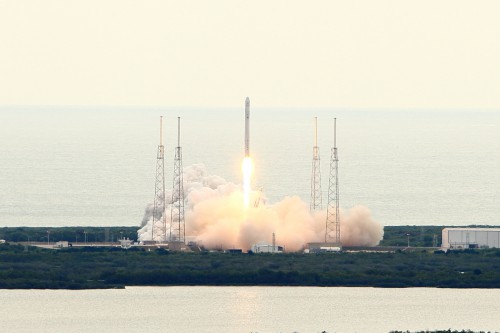
This includes a pair of General Laboratory Active Cryogenic ISS Experiment Refrigerators (GLACIERs), one powered and the other unpowered, to support multiple biological samples with thermal-control requirements between -160°C and +4°C. A spare electronics unit for one of the station’s Minus-Eighty Laboratory Freezers for ISS (MELFI), a Carbon Dioxide Removal Assembly (CDRA) bed, and crew provisions will also be aboard. Attached to the Trunk will be two Heat Rejection Subsystem Grapple Fixtures (HRSGFs), which will provide grapple fixtures to enable the Canadarm2 to interface with ISS radiators, should the need arise to repair or replace them. Shortly after CRS-2 arrives at the space station Saturday, the Trunk external payloads will be robotically removed by Canadarm2, under the control of Ford and Marshburn. They will be temporarily housed on the Mobile Base System of the football-field-sized truss structure to await installation on the S-1 and P-1 truss segments during an EVA by Expedition 36 astronauts Chris Cassidy and Luca Parmitano in June-July.
Dragon’s return to Earth, and a splashdown in the waters of the Pacific Ocean off the coast of southern California, is presently scheduled for 25 March. The spacecraft’s recoverable re-entry capsule will bring over 3,000 pounds of equipment and materials back to Earth, including a GLACIER freezer and several failed environmental control system components. In doing so, Dragon will demonstrate yet again its capacity to pick up and run with the baton from the now-retired space shuttle fleet, providing the United States with a home-grown upmass/downmass capability to and from the ISS.
Following its return to the waters of the Pacific, it appears that subsequent Dragon missions will take place at roughly six-month intervals, with CRS-3 tentatively scheduled to fly on 30 September and CRS-4 in early April 2014. NASA’s contract with SpaceX calls for the company to stage 12 CRS missions in total and deliver around 44,000 pounds of payload to the ISS.
Missions » ISS » COTS » CRS-2 » Missions » ISS »



This was cool and a great Article Ben….What I need to know from the smart rocket people out there is just how difficult is entrying the earth’s atmosphere at 14.3 Km/3 on Titos Blind mission to Mars.
Ut-OH Houston we have a problem….They have lost thruster control??? Can they complete the mission?